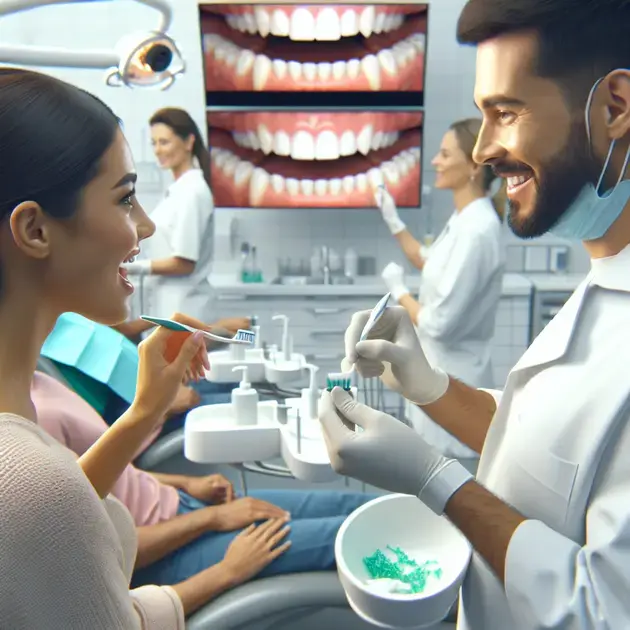When it comes to maintaining oral health, developing healthy habits is key. “Healthy Habits: How to Prevent Plaque and Teeth Issues” is a topic of great importance, as issues like plaque buildup and dental problems can have a significant impact on overall well-being. In today’s fast-paced world, taking proactive measures to prevent these issues is more crucial than ever.
By incorporating simple yet effective habits into your daily routine, you can significantly reduce the risk of plaque buildup and other teeth-related problems. From proper brushing techniques to regular dental check-ups, there are various steps you can take to maintain a healthy smile. Stay tuned as we explore some practical tips and strategies to help you safeguard your oral health and prevent common dental issues.

**
Effective Brushing Techniques**
Introduction:
Effective brushing techniques are crucial for maintaining good oral hygiene and preventing dental issues such as cavities and gum disease. By following the right brushing techniques, you can ensure that your teeth and gums stay healthy and clean. In this guide, we will provide you with step-by-step instructions on how to brush your teeth effectively.
Step 1: Choose the Right Toothbrush and Toothpaste
Start by selecting a soft-bristled toothbrush and fluoride toothpaste. Soft bristles are gentle on your gums and tooth enamel, while fluoride toothpaste helps strengthen your teeth and prevent decay. Look for products with the ADA Seal of Acceptance for quality assurance.
Step 2: Proper Brushing Technique
Hold your toothbrush at a 45-degree angle to the gum line and use gentle circular motions to clean the outer surfaces of your teeth. Brush each tooth individually, moving the brush back and forth to remove plaque and food particles. Don’t forget to brush the inner surfaces and chewing surfaces of your teeth as well.
Step 3: Brush for an Adequate Amount of Time
It’s recommended to brush your teeth for at least two minutes each time. You can use a timer or a toothbrush with a built-in timer to ensure you’re brushing for the right amount of time. Divide your mouth into quadrants and spend about 30 seconds cleaning each quadrant.
Step 4: Don’t Forget Your Tongue
Many people overlook the importance of cleaning their tongue, but it can harbor bacteria and cause bad breath. Use a tongue scraper or your toothbrush to gently clean your tongue from back to front. This simple step can improve your overall oral hygiene.
Step 5: Rinse and Clean Your Toothbrush
After brushing, rinse your mouth with water to remove any remaining toothpaste. Thoroughly rinse your toothbrush and store it in an upright position to air dry. Replace your toothbrush every 3-4 months or sooner if the bristles are frayed.
**
Regular Dental Check-ups**
Introduction:
Regular dental check-ups are essential for maintaining your oral health and catching any potential issues early. Visiting your dentist at least twice a year can prevent dental problems and ensure that your teeth and gums are in good condition. Here’s a step-by-step guide on what to expect during a typical dental check-up.
Step 1: Schedule Your Appointment
Choose a reputable dental clinic in your area and schedule a check-up appointment. You can use websites like Zocdoc or the clinic’s official website to book your visit. Remember to mark the date on your calendar and set a reminder.
Step 2: Dental Examination
During your check-up, the dentist will perform a thorough examination of your teeth, gums, and mouth. They will look for signs of decay, gum disease, and other issues. X-rays may be taken to get a closer look at your teeth and jaw bone.
Step 3: Professional Cleaning
After the examination, a dental hygienist will clean your teeth using special tools to remove plaque and tartar buildup. They will also polish your teeth to remove surface stains and give you a fresh, clean feeling. This step is crucial for preventing cavities and gum disease.
Step 4: Treatment Plan, if Necessary
If the dentist identifies any issues during the check-up, they will discuss a treatment plan with you. This may include fillings, root canals, or other procedures to address dental problems. Follow their recommendations to maintain your oral health.
Step 5: Follow-up Appointments
Depending on your oral health status, the dentist may recommend follow-up appointments for additional treatments or monitoring. Make sure to schedule these appointments promptly to stay on top of your dental care. Regular check-ups can help prevent serious dental issues and save you from costly treatments in the future.
**
Practical Tips for Oral Health**
Introduction:
In addition to effective brushing techniques and regular dental check-ups, there are practical tips you can follow to maintain good oral health. By incorporating these habits into your daily routine, you can keep your smile bright and your mouth healthy. Let’s explore some practical tips for oral health.
Step 1: Healthy Diet and Hydration
Eating a balanced diet rich in fruits, vegetables, and lean proteins can benefit your oral health. Avoid sugary and acidic foods that can contribute to tooth decay. Drink plenty of water throughout the day to help rinse away food particles and keep your mouth hydrated.
Step 2: Avoid Tobacco and Limit Alcohol Consumption
Tobacco use can have detrimental effects on your oral health, including gum disease and oral cancer. If you smoke, consider quitting for the sake of your teeth and gums. Limit your alcohol intake, as excessive alcohol consumption can also harm your oral tissues.
Step 3: Use Mouthwash and Dental Floss
In addition to brushing your teeth, incorporate mouthwash and dental floss into your daily routine. Mouthwash can help kill bacteria and freshen your breath, while flossing removes plaque and food debris between your teeth. Choose products that are ADA-approved for effective oral care.
Step 4: Protect Your Teeth During Physical Activities
If you participate in sports or activities that could pose a risk to your teeth, wear a mouthguard to protect them from injury. A custom-fitted mouthguard from your dentist offers the best protection and comfort. Don’t forget to replace your mouthguard if it becomes worn or damaged.
Step 5: Manage Stress for Oral Health
Stress can manifest in oral health issues like teeth grinding and jaw clenching. Practice stress-relief techniques such as meditation, exercise, or deep breathing to keep your stress levels in check. Avoid using your teeth as tools to open packages or chew on non-food items when feeling stressed. By managing stress effectively, you can safeguard your oral health and overall well-being.

Effective Flossing Techniques
Flossing is an essential part of maintaining good oral hygiene. Proper flossing techniques can help remove food particles and plaque from between the teeth, where a toothbrush may not reach. Here is a step-by-step guide on how to floss effectively:
1. Choose the Right Type of Floss
There are different types of floss available, such as waxed, unwaxed, ribbon, and tape floss. Choose one that is comfortable for you to use and easily fits between your teeth.
2. Use an Adequate Length of Floss
Cut a piece of floss that is about 18 inches long. This allows you to use a fresh section of floss for each tooth without reusing the same part, which can spread bacteria.
3. Proper Technique
Hold the floss tightly between your thumbs and forefingers and gently insert it between your teeth. Curve the floss into a “C” shape around each tooth and slide it up and down to clean the sides of the teeth.
4. Be Gentle
Avoid snapping the floss into your gums, as this can cause irritation and bleeding. Use a gentle sawing motion to move the floss between your teeth.
5. Floss Daily
Make flossing a part of your daily dental routine. By flossing at least once a day, you can help prevent cavities and gum disease, promoting overall oral health.
Balanced Diet for Dental Health
A balanced diet plays a significant role in maintaining good dental health. Eating the right foods can help strengthen teeth, prevent cavities, and promote healthy gums. Here are some tips on how to maintain a balanced diet for dental health:
1. Limit Sugary Foods
Sugary foods and beverages can contribute to tooth decay. Limit the intake of sugary snacks and opt for healthier alternatives like fruits and vegetables.
2. Calcium-Rich Foods
Include calcium-rich foods such as dairy products, leafy greens, and almonds in your diet. Calcium helps strengthen teeth and bones, promoting overall oral health.
3. Drink Plenty of Water
Water is essential for maintaining good oral health. It helps wash away food particles and bacteria that can lead to cavities and gum disease.
4. Balanced Meals
Eat a balanced diet that includes a variety of nutrients. Incorporate whole grains, lean proteins, fruits, and vegetables into your meals to ensure you are getting essential vitamins and minerals for oral health.
5. Avoid Acidic Foods
Acidic foods and beverages can erode tooth enamel. Limit your consumption of acidic foods like citrus fruits and carbonated drinks to protect your teeth.
Promoting Gum Health
Gum health is as important as dental health when it comes to maintaining a healthy mouth. Healthy gums can help prevent gum disease and other oral health issues. Here are some tips for promoting gum health:
1. Brush and Floss Regularly
Proper oral hygiene, including brushing your teeth twice a day and flossing daily, is essential for gum health. Removing plaque and bacteria from the gumline can help prevent gum disease.
2. Use Antiseptic Mouthwash
Rinsing with an antiseptic mouthwash can help reduce bacteria in the mouth that can cause gum disease. Look for a mouthwash that is specifically designed for gum health.
3. Eat Foods High in Vitamins C and D
Vitamin C and D are important for gum health. Include foods like citrus fruits, berries, and oily fish in your diet to help maintain healthy gums.
4. Avoid Smoking
Smoking can increase the risk of gum disease and other oral health problems. Quitting smoking can significantly improve gum health and overall oral health.
5. Regular Dental Check-ups
Visit your dentist regularly for check-ups and cleanings. Your dentist can detect early signs of gum disease and provide treatment to prevent further complications.
Conclusion
In conclusion, maintaining good oral hygiene through effective flossing techniques, a balanced diet for dental health, and promoting gum health is essential for overall oral health. Flossing daily using the right type of floss and proper technique can help prevent cavities and gum disease by removing food particles and plaque from between the teeth. It is crucial to be gentle while flossing to avoid gum irritation and bleeding, making it a part of your daily dental routine.
Balanced diet plays a significant role in strengthening teeth, preventing cavities, and promoting healthy gums. Limiting sugary foods, consuming calcium-rich foods, drinking plenty of water, eating balanced meals, and avoiding acidic foods contribute to maintaining good dental health. Vitamin C and D are important for gum health, while smoking can increase the risk of gum disease, emphasizing the need to quit smoking for improved gum health.
Promoting gum health involves regular brushing and flossing, using antiseptic mouthwash, eating foods rich in vitamins C and D, avoiding smoking, and scheduling regular dental check-ups. These practices help prevent gum disease and other oral health issues, ensuring a healthy mouth. By following these guidelines, individuals can achieve optimal oral health and prevent potential dental problems, leading to a confident and healthy smile!